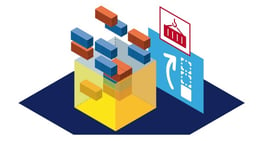The Marriage of Industry 4.0 and Job Shop Scheduling
Brian Hoey - August 28, 2018

 For decades, production planners in non-clocked production environments have been trying to optimize their job shop scheduling processes, and for decades the problem has continued to elude them, owing in large part to the tremendous complexity of uncovering the most efficient route for each product to take through a non-linear production environment. Luckily, new advancements in supply chain technology are constantly presenting planners with new tools and tactics they can use for gaining the maximum possible value from their production workflows. In many ways, the most significant of these advancements come in the form of the new technologies that make up the Industry 4.0 revolution. But what, exactly, is it that makes Industry 4.0 and job shop scheduling a match made in heaven?
For decades, production planners in non-clocked production environments have been trying to optimize their job shop scheduling processes, and for decades the problem has continued to elude them, owing in large part to the tremendous complexity of uncovering the most efficient route for each product to take through a non-linear production environment. Luckily, new advancements in supply chain technology are constantly presenting planners with new tools and tactics they can use for gaining the maximum possible value from their production workflows. In many ways, the most significant of these advancements come in the form of the new technologies that make up the Industry 4.0 revolution. But what, exactly, is it that makes Industry 4.0 and job shop scheduling a match made in heaven?
The Challenges of Job Shop Scheduling
To begin with, it’s worth giving a quick discussion of the factors that make non-timed production planning such a thorny problem for so many planners. In short, unlike in the case of assembly lines or other linear production environments, there is no set path that each product takes from one machine or person to the next. Resource usage can be radically different from one production process to another, meaning that it can be difficult to determine the most efficient way to produce multiple different products or parts.
As a result of the non-linear nature of non-clocked production, many job shop planners still conduct their planning processes with pen and ink or using an Excel spreadsheet. Though this might seem like a low-risk proposition for a workflow that has historically been opaque and inflexible at best, the tendency to keep non-timed production plans out of the highly visible digital environments that define modern manufacturing can actually exacerbate its inherent difficulties. Without the type of commitment to transparency on display in other modern planning workflows, it can be difficult or even impossible to insert a modicum of agility into non-timed production plans. As a result, when any sort of disruption occurs, from a machine breakdown to a parts shortage, a complete manual replanning is often required.
A Technological Solution
Enter Industry 4.0. With its commitment to digitization and machine interconnectivity, Industry 4.0 lays the groundwork for more open, transparent, and adaptable processes across all touchpoints on the value chain, including processes like job shop scheduling that have traditionally been resistant to such things. In an Industry 4.0 environment, for instance, it’s possible to create a digital twin of your production facility in which different processes can be mapped out, simulated, and analyzed. In the case of job shop scheduling, this level of digitization makes it possible to train complex software solutions on any given planning challenge in order to create optimal non-timed production plans in a manner that is faster and more efficacious than would reasonably be possible in a manual planning workflow. More than that, Industry 4.0 systems offer planners the tools to simulate disruptions and create contingency plans to be utilized in case of machine malfunctions, sudden demand fluctuations, or other potentials snags.
To further elucidate the transformative power of Industry 4.0 on a job-shop environment let’s envision a hypothetical: Your production facilities are fully leveraged with what you’ve determined is the optimal schedule for meeting demand in a timely fashion, when one of your suppliers misses a delivery that would affect about a quarter of your products. In a pre-Industry 4.0 environment, you would be stuck either leaving the machines unused during the time in which that quarter of your products would be under production, or doing a replanning from scratch and potentially delaying production even further. Conversely, with the type of sophisticated IT infrastructure that Industry 4.0 implies, the disruption could have already been planned for by software trained on real-time production feedback routed via internet of things (IoT) sensors back to a central planning database.
Not only could planners implement this backup plan in order to retain the maximum amount of value, the new production scheme would continue sending feedback to the job shop scheduling solution so that key stakeholders could gain an understanding of their production workflows in a centralized, highly visible real-time environment, enabling them to study target-actual comparisons, run sophisticated advanced analytics processes, and generally refine their overall production stream. In this way, Industry 4.0 systems finally offer a solution to the otherwise-thorny problems inherent in job shop scheduling.
LATEST POSTS
- Understand Circular Economy in The Manufacturing Industry
- How Can Industry 4.0 IT Integration Be Achieved Smoothly?
- The Significance of Order Sequencing in Discrete Manufacturing
- How to improve your Supply Chain Management: The Power of Control Towers
- Optimizing Human Resource Scheduling in Manufacturing: A Technological Approach



